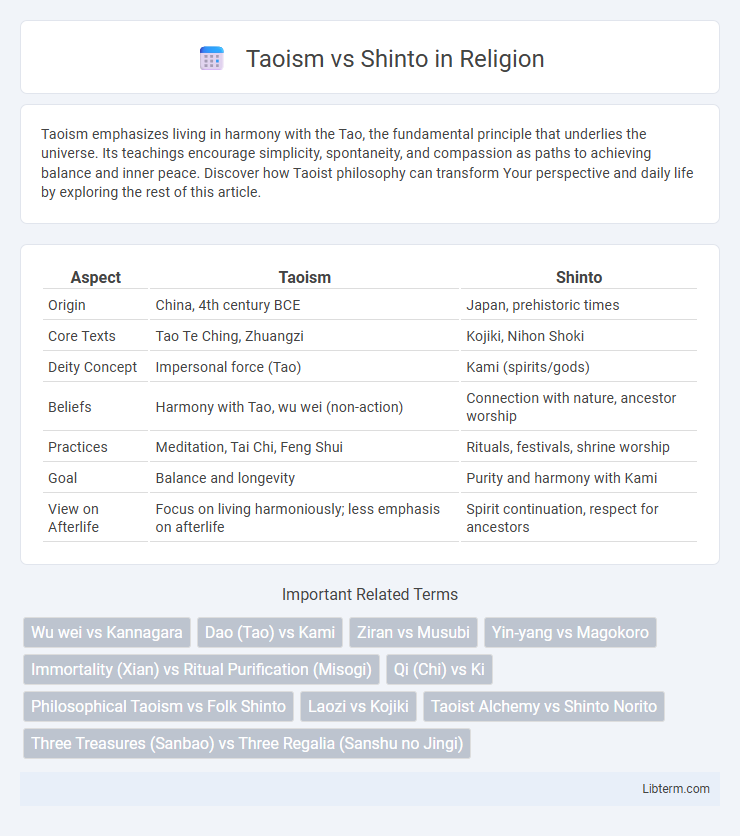Taoism emphasizes living in harmony with the Tao, the fundamental principle that underlies the universe. Its teachings encourage simplicity, spontaneity, and compassion as paths to achieving balance and inner peace. Discover how Taoist philosophy can transform Your perspective and daily life by exploring the rest of this article.
Table of Comparison
| Aspect | Taoism | Shinto |
|---|---|---|
| Origin | China, 4th century BCE | Japan, prehistoric times |
| Core Texts | Tao Te Ching, Zhuangzi | Kojiki, Nihon Shoki |
| Deity Concept | Impersonal force (Tao) | Kami (spirits/gods) |
| Beliefs | Harmony with Tao, wu wei (non-action) | Connection with nature, ancestor worship |
| Practices | Meditation, Tai Chi, Feng Shui | Rituals, festivals, shrine worship |
| Goal | Balance and longevity | Purity and harmony with Kami |
| View on Afterlife | Focus on living harmoniously; less emphasis on afterlife | Spirit continuation, respect for ancestors |
Introduction to Taoism and Shinto
Taoism, originating in ancient China, emphasizes living in harmony with the Tao, the fundamental principle underlying the universe, promoting simplicity, spontaneity, and compassion. Shinto, the indigenous spirituality of Japan, centers on kami, spirits representing natural elements and ancestors, fostering rituals and practices that honor these divine forces. Both religions influence East Asian culture profoundly, shaping ethical values, art, and social traditions.
Historical Origins and Development
Taoism originated in ancient China during the 4th century BCE, rooted in the teachings of Laozi and the foundational text *Tao Te Ching*, emphasizing harmony with the Tao or "the Way." Shinto, Japan's indigenous religion, evolved from ancient animistic beliefs and rituals centered around kami, sacred spirits, with formal development around the 8th century CE through texts like the *Kojiki* and *Nihon Shoki*. Both traditions deeply influenced East Asian culture, with Taoism shaping Chinese philosophy and medicine, while Shinto influenced Japanese festivals, rituals, and the imperial system.
Core Philosophical Beliefs
Taoism centers on living in harmony with the Tao, the fundamental principle that is the source of everything, emphasizing wu wei (non-action) and natural spontaneity. Shinto emphasizes reverence for kami, spirits present in nature and ancestors, focusing on ritual purity, community, and worship practices without a formalized doctrine. Both systems seek balance and connection with the natural world but differ in metaphysical focus: Taoism explores cosmic unity, while Shinto prioritizes ritual and divine presence in the material world.
Key Deities and Spiritual Figures
Taoism centers around deities such as Laozi, considered the founder and personification of the Tao, and the Jade Emperor, ruler of heaven and the universe. Shinto worships kami, spirits embodying natural elements and ancestors, with Amaterasu, the sun goddess, playing a central role as the mythological ancestor of the Japanese imperial family. Both religions emphasize spiritual harmony but differ in their pantheon structure, with Taoism's deities often representing cosmic principles and Shinto's kami rooted in nature and ancestral reverence.
Sacred Texts and Teachings
Taoism centers on foundational texts like the Tao Te Ching and Zhuangzi, emphasizing harmony with the Tao, the underlying natural order, and principles such as wu wei (non-action) and simplicity. Shinto, rooted in Japanese tradition, relies on ancient texts like the Kojiki and Nihon Shoki that document kami (spirits) worship, rituals, and the mythological origins of Japan, prioritizing purity, reverence for nature, and ancestral veneration. Both religions focus on living in accordance with spiritual forces but differ significantly in their textual traditions and theological frameworks.
Rituals and Worship Practices
Taoism emphasizes rituals such as meditation, Tai Chi, and offerings to deities aimed at harmonizing with the Tao and achieving spiritual balance, often performed in temples or nature. Shinto rituals center on purification, shrine visits, and seasonal festivals honoring kami, with practices like misogi (water purification) and norito (prayers) to maintain a connection between humans, nature, and ancestral spirits. While Taoist worship often includes alchemy and divination, Shinto worship prioritizes ritual cleanliness and community participation without a formal scripture.
Relationship with Nature
Taoism emphasizes living in harmony with the Tao, the fundamental principle underlying the natural world, encouraging simplicity and flowing with natural forces. Shinto centers on kami, spirits inherent in natural elements like trees, rivers, and mountains, fostering rituals that honor and connect with these sacred entities. Both philosophies cultivate a profound respect for nature but approach it through different spiritual frameworks and practices.
Role in Society and Daily Life
Taoism emphasizes harmony with nature and the flow of life energy (qi), influencing traditional Chinese medicine, martial arts, and family rituals, fostering balance and spiritual health in daily life. Shinto centers on kami worship and rituals that honor ancestors and natural spirits, deeply integrating festivals, shrine visits, and purification rites into Japanese cultural and community practices. Both religions shape social values and customs, with Taoism promoting individual spiritual cultivation and Shinto reinforcing community cohesion and respect for nature.
Modern Influence and Global Presence
Taoism profoundly influences global wellness practices through tai chi and traditional Chinese medicine, integrating ancient spiritual principles with modern holistic health trends. Shinto's modern presence remains primarily concentrated in Japan, conveyed through rituals and festivals that emphasize harmony with nature and cultural identity in a technologically advanced society. Both religions contribute uniquely to contemporary spirituality, with Taoism extending its reach internationally while Shinto preserves its localized cultural heritage.
Comparative Analysis: Similarities and Differences
Taoism and Shinto both emphasize harmony with nature, spiritual balance, and the importance of rituals in daily life, reflecting their roots in East Asian cultural contexts. Taoism centers on the Tao, or the fundamental cosmic force, promoting simplicity and non-action (wu wei), while Shinto focuses on kami, divine spirits associated with natural elements and ancestral worship. Despite overlapping themes of reverence for nature and spirituality, Taoism integrates philosophical and metaphysical teachings, whereas Shinto remains primarily a ritualistic indigenous religion centered on community and purification rites.
Taoism Infographic

 libterm.com
libterm.com